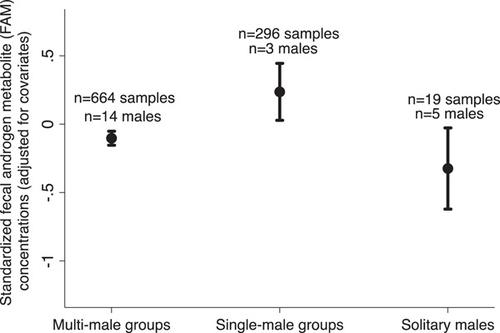当前位置:
X-MOL 学术
›
Am. J. Primatol.
›
论文详情
Our official English website, www.x-mol.net, welcomes your
feedback! (Note: you will need to create a separate account there.)
Group structure, but not dominance rank, predicts fecal androgen metabolite concentrations of wild male mountain gorillas (Gorilla beringei beringei)
American Journal of Primatology ( IF 2.0 ) Pub Date : 2021-07-05 , DOI: 10.1002/ajp.23295 Stacy Rosenbaum 1, 2 , Winnie Eckardt 3, 4 , Tara S Stoinski 4 , Rose Umuhoza 3 , Christopher W Kuzawa 5, 6 , Rachel M Santymire 2
American Journal of Primatology ( IF 2.0 ) Pub Date : 2021-07-05 , DOI: 10.1002/ajp.23295 Stacy Rosenbaum 1, 2 , Winnie Eckardt 3, 4 , Tara S Stoinski 4 , Rose Umuhoza 3 , Christopher W Kuzawa 5, 6 , Rachel M Santymire 2
Affiliation

|
Androgens are important mediators of male-male competition in many primate species. Male gorillas' morphology is consistent with a reproductive strategy that relies heavily on androgen-dependent traits (e.g., extreme size and muscle mass). Despite possessing characteristics typical of species with an exclusively single-male group structure, multimale groups with strong dominance hierarchies are common in mountain gorillas. Theory predicts that androgens should mediate their dominance hierarchies, and potentially vary with the type of group males live in. We validated the use of a testosterone enzyme immunoassay (T-EIA R156/7, CJ Munro, UC-Davis) for use with mountain gorilla fecal material by (1) examining individual-level androgen responses to competitive events, and (2) isolating assay-specific hormone metabolites via high-performance liquid chromatography. Males had large (2.6- and 6.5-fold), temporary increases in fecal androgen metabolite (FAM) after competitive events, and most captured metabolites were testosterone or 5α-dihydrotestosterone-like androgens. We then examined the relationship between males' dominance ranks, group type, and FAM concentrations. Males in single-male groups had higher FAM concentrations than males in multimale groups, and a small pool of samples from solitary males suggested they may have lower FAM than group-living peers. However, data from two different time periods (n = 1610 samples) indicated there was no clear relationship between rank and FAM concentrations, confirming results from the larger of two prior studies that measured urinary androgens. These findings highlight the need for additional research to clarify the surprising lack of a dominance hierarchy/androgen relationship in mountain gorillas.
中文翻译:

群结构,但不是优势等级,预测野生雄性山地大猩猩 (Gorilla beringei beringei) 的粪便雄激素代谢物浓度
雄激素是许多灵长类动物雄性竞争的重要介质。雄性大猩猩的形态与严重依赖雄激素依赖性特征(例如,极端体型和肌肉质量)的生殖策略一致。尽管具有完全单一雄性群体结构的物种的典型特征,但具有强大优势等级的多雄性群体在山地大猩猩中很常见。理论预测雄激素应该调节它们的优势层次结构,并且可能会随着男性群体的类型而变化。通过(1)检查个体水平的雄激素对竞争事件的反应,(2) 通过高效液相色谱分离测定特异性激素代谢物。男性在比赛后粪便雄激素代谢物 (FAM) 有大量(2.6 倍和 6.5 倍)暂时增加,并且大多数捕获的代谢物是睾酮或 5α-二氢睾酮样雄激素。然后我们检查了男性的优势等级、群体类型和 FAM 浓度之间的关系。单雄性组中的雄性比多雄性组中的雄性具有更高的 FAM 浓度,并且来自独居雄性的一小部分样本表明它们的 FAM 可能低于群体生活的同龄人。然而,来自两个不同时间段的数据(大多数捕获的代谢物是睾酮或 5α-二氢睾酮样雄激素。然后我们检查了男性的优势等级、群体类型和 FAM 浓度之间的关系。单雄性组中的雄性比多雄性组中的雄性具有更高的 FAM 浓度,并且来自独居雄性的一小部分样本表明它们的 FAM 可能低于群体生活的同龄人。然而,来自两个不同时间段的数据(大多数捕获的代谢物是睾酮或 5α-二氢睾酮样雄激素。然后我们检查了男性的优势等级、群体类型和 FAM 浓度之间的关系。单雄性组中的雄性比多雄性组中的雄性具有更高的 FAM 浓度,并且来自独居雄性的一小部分样本表明它们的 FAM 可能低于群体生活的同龄人。然而,来自两个不同时间段的数据(n = 1610 个样本)表明等级和 FAM 浓度之间没有明确的关系,这证实了之前两项测量尿雄激素的研究中较大者的结果。这些发现强调需要进行额外的研究来澄清山地大猩猩中令人惊讶地缺乏优势等级/雄激素关系。
更新日期:2021-07-22
中文翻译:

群结构,但不是优势等级,预测野生雄性山地大猩猩 (Gorilla beringei beringei) 的粪便雄激素代谢物浓度
雄激素是许多灵长类动物雄性竞争的重要介质。雄性大猩猩的形态与严重依赖雄激素依赖性特征(例如,极端体型和肌肉质量)的生殖策略一致。尽管具有完全单一雄性群体结构的物种的典型特征,但具有强大优势等级的多雄性群体在山地大猩猩中很常见。理论预测雄激素应该调节它们的优势层次结构,并且可能会随着男性群体的类型而变化。通过(1)检查个体水平的雄激素对竞争事件的反应,(2) 通过高效液相色谱分离测定特异性激素代谢物。男性在比赛后粪便雄激素代谢物 (FAM) 有大量(2.6 倍和 6.5 倍)暂时增加,并且大多数捕获的代谢物是睾酮或 5α-二氢睾酮样雄激素。然后我们检查了男性的优势等级、群体类型和 FAM 浓度之间的关系。单雄性组中的雄性比多雄性组中的雄性具有更高的 FAM 浓度,并且来自独居雄性的一小部分样本表明它们的 FAM 可能低于群体生活的同龄人。然而,来自两个不同时间段的数据(大多数捕获的代谢物是睾酮或 5α-二氢睾酮样雄激素。然后我们检查了男性的优势等级、群体类型和 FAM 浓度之间的关系。单雄性组中的雄性比多雄性组中的雄性具有更高的 FAM 浓度,并且来自独居雄性的一小部分样本表明它们的 FAM 可能低于群体生活的同龄人。然而,来自两个不同时间段的数据(大多数捕获的代谢物是睾酮或 5α-二氢睾酮样雄激素。然后我们检查了男性的优势等级、群体类型和 FAM 浓度之间的关系。单雄性组中的雄性比多雄性组中的雄性具有更高的 FAM 浓度,并且来自独居雄性的一小部分样本表明它们的 FAM 可能低于群体生活的同龄人。然而,来自两个不同时间段的数据(n = 1610 个样本)表明等级和 FAM 浓度之间没有明确的关系,这证实了之前两项测量尿雄激素的研究中较大者的结果。这些发现强调需要进行额外的研究来澄清山地大猩猩中令人惊讶地缺乏优势等级/雄激素关系。











































 京公网安备 11010802027423号
京公网安备 11010802027423号